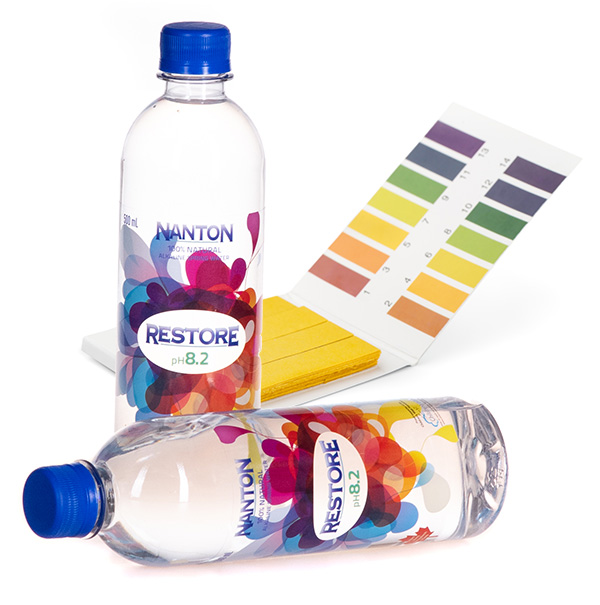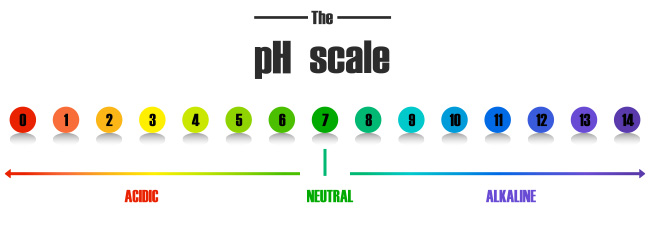Nanton pH 8.2 Water
What is pH?
A measure of acidity (or alkalinity) is known as pH. More specifically it is an electrochemical expression of the amount of hydrogen ions in a liquid or a liquid containing substance. Pure water is the bench mark with a neutral pH of 7. With each 1 point increase (from 7 to 8 for example) there is a 10 fold decrease in hydrogen atoms with increasing pH and vice versa. With each 1 point decrease the solution becomes more acidic and there is a 10 fold decrease in the number of hydrogen ions.
The presence of substances in drinking water or in any solution can cause an increase or decrease in hydrogen ions and therefore in pH.
Certain impurities can make the water more acidic, while important minerals for human health like calcium, magnesium and potassium.
Various portions of the body require different degrees of pH. The blood maintains a very tightly controlled pH of between 7.2 to 7.4 and deviation form that can be harmful to your health. The internal environment of human cells is slightly acidic with the pH of 6.8, while the environment outside the cells is slightly alkaline at a pH of 7.4.

Try our premium alkaline spring water.
While changes in cellular and extracellular pH are not as drastic as those of blood plasma, they can be both a reflection of or contribute to disease. These changes occur when various stressors (poor diet, harmful substances etc.) affect the cells in such a way that the cells lose vital minerals such as potassium and magnesium.
What Disrupts the Body’s pH?
Mild chronic acidosis often results from prescription drugs, stress and pollution, as well as overconsumption of acid producing foods. A diet rich in polyunsaturated oil, processed foods (devoid of minerals from fruit and vegetables), and other unhealthy foods such as refined carbohydrates, sugar, carbonated drinks and alcohol consumption can all contribute to your body’s pH being out of balance.
Tips For Restoring Acid/Alkaline Balance
1. Drink Plenty of Water
Water is required for good health. Did you know that certain aspects of water quality can influence your health in various ways? Pure alkaline water with a balance of the right minerals can be particularly healthful. Pristine alkaline spring water, rich in naturally occurring minerals such as magnesium and potassium can help improve mineral status, hydration and alkalinity as to support healthy cellular function. The health authorities commonly recommend eight 8-ounce glasses, which equals about 2 liters, or half a gallon. This is called the 8×8 rule and is very easy to remember.
2. Reduce Alcohol Consumption
3. Get Rid of Artificial Sweeteners But Keep Your Stevia

4. Eat More Fresh Produce
Eat more fruits and vegetables as most are alkaline based and rich in vitamins and minerals.
5. Boost Your Beans and Seeds
Soy, navy, and lima beans are all highly alkaline, while caraway, cumin, fennel and sesame seeds are good for raising pH too.
6. Aim for a 70-30 Ratio of Alkaline to Acid Foods
7. Ban Refined Carbohydrates
Unless you are opting for a minimal amount of sprouted grains, get rid of tortillas, white bread, white flour, cakes, sugar, cookies and white rice.
How to Test Your pH
By now you might be intrigued about giving this alkaline diet a try, but how can you tell if it’s working? The good news is that you can easily test your pH levels at home. Just head to your local drugstore or health food store and pick up a pack of pH test strips.
You can test your pH levels often throughout the day, but try to do so at the same time each morning, as your body will be more acidic the earlier you measure. The best time to perform your saliva pH test is one hour before or two hours after a meal, twice per week. Wait at least two hours after eating to measure your saliva pH.
- Fill your mouth with saliva, then swallow.
- Repeat step one to ensure saliva is clean.
- Fill your mouth with saliva and put some of your saliva on the pH strip provided.
- Wait for a few seconds until the paper stops changing colour.

The test strip should turn green, indicating that your saliva is a slightly alkaline, and a healthy pH of 7.4.
If it is not green compare with the chart above. If your saliva is below 7.0 (acidic) wait for two hours and repeat the test.
If you’re not ready to completely overhaul your diet, that’s OK. Aim for about a 70-30 ratio of alkaline to acid foods. In addition to the foods you eat, know that stress can also affect your pH levels. Practice deep breathing, eat your veggies and drink plenty of water to lighten your acidic load.
